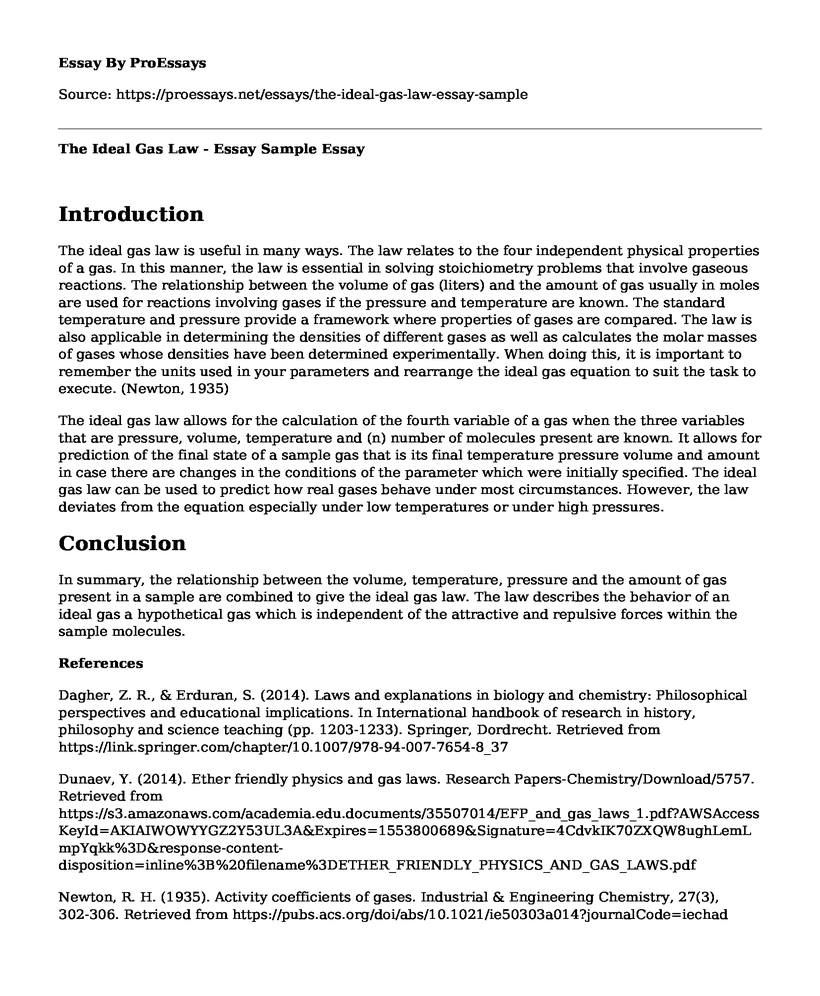Introduction
The ideal gas law is useful in many ways. The law relates to the four independent physical properties of a gas. In this manner, the law is essential in solving stoichiometry problems that involve gaseous reactions. The relationship between the volume of gas (liters) and the amount of gas usually in moles are used for reactions involving gases if the pressure and temperature are known. The standard temperature and pressure provide a framework where properties of gases are compared. The law is also applicable in determining the densities of different gases as well as calculates the molar masses of gases whose densities have been determined experimentally. When doing this, it is important to remember the units used in your parameters and rearrange the ideal gas equation to suit the task to execute. (Newton, 1935)
The ideal gas law allows for the calculation of the fourth variable of a gas when the three variables that are pressure, volume, temperature and (n) number of molecules present are known. It allows for prediction of the final state of a sample gas that is its final temperature pressure volume and amount in case there are changes in the conditions of the parameter which were initially specified. The ideal gas law can be used to predict how real gases behave under most circumstances. However, the law deviates from the equation especially under low temperatures or under high pressures.
Conclusion
In summary, the relationship between the volume, temperature, pressure and the amount of gas present in a sample are combined to give the ideal gas law. The law describes the behavior of an ideal gas a hypothetical gas which is independent of the attractive and repulsive forces within the sample molecules.
References
Dagher, Z. R., & Erduran, S. (2014). Laws and explanations in biology and chemistry: Philosophical perspectives and educational implications. In International handbook of research in history, philosophy and science teaching (pp. 1203-1233). Springer, Dordrecht. Retrieved from https://link.springer.com/chapter/10.1007/978-94-007-7654-8_37
Dunaev, Y. (2014). Ether friendly physics and gas laws. Research Papers-Chemistry/Download/5757. Retrieved from https://s3.amazonaws.com/academia.edu.documents/35507014/EFP_and_gas_laws_1.pdf?AWSAccessKeyId=AKIAIWOWYYGZ2Y53UL3A&Expires=1553800689&Signature=4CdvkIK70ZXQW8ughLemLmpYqkk%3D&response-content-disposition=inline%3B%20filename%3DETHER_FRIENDLY_PHYSICS_AND_GAS_LAWS.pdf
Newton, R. H. (1935). Activity coefficients of gases. Industrial & Engineering Chemistry, 27(3), 302-306. Retrieved from https://pubs.acs.org/doi/abs/10.1021/ie50303a014?journalCode=iechad
Woody, A. I. (2013). How is the ideal gas law explanatory? Science & Education, 22(7), 1563-1580. Retrieved from https://link.springer.com/article/10.1007/s11191-011-9424-6
Cite this page
The Ideal Gas Law - Essay Sample. (2022, Dec 17). Retrieved from https://proessays.net/essays/the-ideal-gas-law-essay-sample
If you are the original author of this essay and no longer wish to have it published on the ProEssays website, please click below to request its removal:
- Drugs Dosage
- Mongolian Empire
- The Role of Latent Heat While Phases Are Changing Paper Example
- Thermodynamics Fundamentals Paper Example
- Nature of Magnetic Surfactants Essay Example
- Essay Sample on BLEVE: A Potentially Devastating Chemical Industry Accident
- Mass Spectrometry for Determining Substance Concentrations in Individuals - Essay Sample







